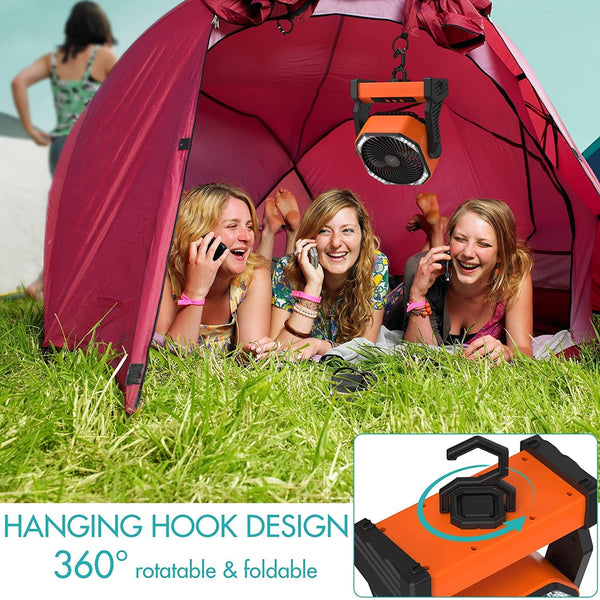A tent fan is handy for very warm temperatures and still weather, when the climate inside the tent body can become uncomfortable for relaxing or sleeping.
The fan aids evaporation from the skin, cooling the body.
A camping fan can also provide air circulation inside a tent that doesn’t have enough screen area, has been closed up for privacy or has been sealed against the rain.
A tent fan features multiple speeds to move more air or to conserve battery power. The fan may also offer an LED night light to illuminate the tent body after dark.
A camping fan is also useful in cool weather, where it can provide enough air circulation inside the tent body to reduce condensation.
Since tent fans run on small household batteries, they are easy to transport, making them ideal for enhancing family tent camping.
A tent fan does not have to be specifically labeled as a tent fan. Any battery-powered personal, desk or travel fan will work. Tent fans mainly have special attachment points for tent ceiling loops or for tent fabric and run on D-cell batteries, so they have plenty of current to run for long periods of time.
If you’re renting a campsite with electricity, you can pack a house fan to ventilate the tent.
At what outdoor temperature and conditions will I want a fan?
Many tent campers will probably desire a fan once the heat index approaches 80 deg F, if there is no breeze to ventilate the tent.
Warm days tend to be still days, so campers are less likely to get a comfortable breeze on these days.
(If winds pick up on very warm days, they are more likely to be storm winds, instead of comfortable breezes.)
Will a tent fan be enough?
A tent fan should be adequate for most campers on very warm days.
Once the heat-index temperature approaches body temperature, a fan will no longer have a cooling effect. In fact, it can make the body less comfortable.
On a hot, humid day (heat index of 90+ deg F or 30+ deg C), a tent fan will no longer be effective. Family campers who would like to tent camp in this weather may need to consider an air conditioner.
However, tent fans are far more portable than air conditioners and run on batteries, instead of on 120-volt electricity. Campers will need to determine for themselves the trade off between portability, power draw and comfort.
Where should I place a tent fan?
A tent fan with a base can be placed on the floor in front of a screen door or a low vent in order to increase ventilation into the tent.
A tent fan with a hook at the base can be hung from a ceiling loop.
A tent fan with a magnetic base can be attached to tent-body fabric or a screen.
A tent fan can be placed on the gear loft netting, aimed either down or up, depending on preference and comfort.
Depending on size and throughput, it can be used either for spot cooling or for improving the climate inside the tent body.
How long will a tent fan powered by household batteries run?
A tent fan might run from 12 to 72 hours before the batteries need to be replaced, depending on the speed setting, and the amount of battery power available.
This can be enough for a night and a few hours during the day, enough for a weekend, or enough for several nights.
Tent fans are designed to either circulate air throughout the tent, to provide spot cooling for a single camper, or both.
Camping fans are D-cell powered units using from 1 to 8 alkaline batteries. More batteries offer more ventilation or longer runtime.
Small, personal, spot-cooling fans are available that attach to tent fabric via magnets and stream air over a single camper. This fan has soft, small blades with no cage around them. It usually runs on a single battery.
A medium-size camping fan can ventilate a tent body. This is often a 6-volt device, running on 4 D-cell alkaline batteries.
If renting a tent campsite with electricity, you can bring a house fan.



